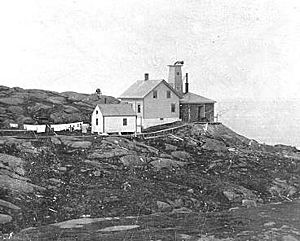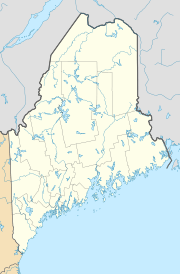Manana Island Sound Signal Station facts for kids
 |
|
| Undated US Coast Guard photo | |
|
|
|
| Location | Manana Island, Maine |
|---|---|
| Coordinates | 43°45′48″N 69°19′36″W / 43.76327°N 69.32666°W |
| Year first constructed | 1855 |
| Automated | 1988 |
| Tower shape | Brick House |
| Markings / pattern | Brown |
| Fog signal | HORN: 2 every 60s |
| USCG number | 1-25 |
The Manana Island Sound Signal Station is a special place in Maine, United States. It helps ships find their way in foggy weather. This station is on Manana Island. It started working way back in 1855.
What makes it unique? It's one of the few fog signal stations in the U.S. that works mostly on its own. It has not always been connected to the Monhegan Island Light. It also has the only known "trumpet tower" for a fog signal, built in 1889. The station was added to the National Register of Historic Places in 2002.
Contents
What Does the Station Look Like?
Monhegan is a small island community about 10 miles (16 km) off the coast of Maine. It includes Monhegan Island and other smaller islands nearby. The harbor is between Monhegan and Manana Islands.
The Manana Island Sound Signal Station is at the highest point on Manana Island. It has several buildings.
- The current fog signal equipment is in a small brick building. This building was built in 1906. It stands on the foundation of the first signal house.
- The main signal building is a brick structure. It is about 33 feet (10 m) long and 20 feet (6.1 m) wide. It was built in 1889. This building has a low tower on top. This tower once held a special device called a Daboll trumpet.
- A shed is attached to the side of the main building. It covers large iron tanks that hold air pressure.
- The keeper's house dates back to 1855. This wooden building has been changed a lot over the years.
Moving Supplies to the Station
The station uses a special electromechanical hoist. This helps move materials to the site. It has a set of rails that go from the boat landing to a hoist house. The hoist house holds the motor. This system was built in 1905 and is still used today.
History of the Fog Signal
Monhegan Island has always been an important landmark for ships in Maine. It often gets very foggy. Because of this, the United States Lighthouse Board suggested building a fog signal on Manana Island in 1853.
Early Signals and Changes
- In 1854, money was set aside for the station.
- In 1855, a bell was installed on Manana Island. People had to ring it by hand.
- In 1856, a machine was added to strike the bell automatically.
- In 1870, a steam-powered Daboll trumpet was installed. This was a new invention at the time.
- In 1872, the trumpet was replaced with a whistle. The trumpet was then moved to the Portland Head Light.
Becoming Independent and Modernizing
- The fog signal was first managed by the Monhegan Island Light. But in 1876, it became its own separate station.
- In 1877, a new Daboll trumpet was installed.
- In 1912, an air siren replaced the trumpet.
- In 1937, a radio beacon was added to help ships even more.
- The station became automated in 1986. This means machines took over the work.
- The radio tower was removed in 1995.



